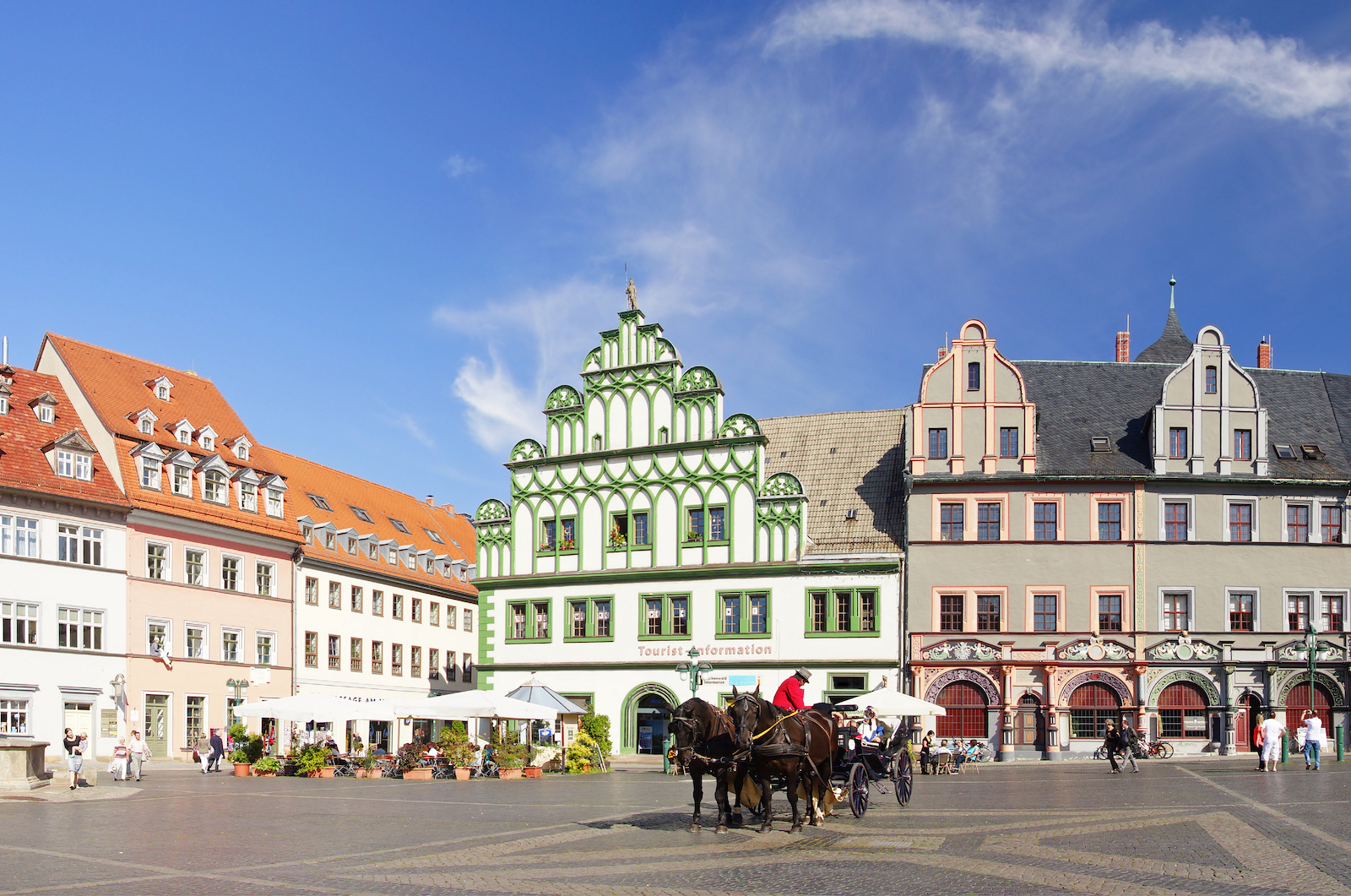He was opposed to weddings. He was said to keep a weather glass in his room to foretell coming storms. He was particular about the colours in his home and wrote about the effect aesthetic choices had on his mood. He loved Italy, and of Sicily he wrote, “It is the clue to everything.” The German poet Johann Wolfgang von Goethe, known most famously for Faust, lived most of his life in Weimar, a city that has become a site of pilgrimage akin to Shakespeare’s Stratford-upon-Avon or Dante’s Florence.
The city of Weimar, nestled amid the rolling hills in the eastern state of Thuringia, is about a two-hour train ride from Berlin, where I’ve lived for two years, yet this is my first visit. When I told my German friends I was going, they simply said, “Finally.” To visit Weimar, they said, would be to finally know Germany. How I desired to understand this new home, this country of der Dichter und Denker, the poets and the thinkers.
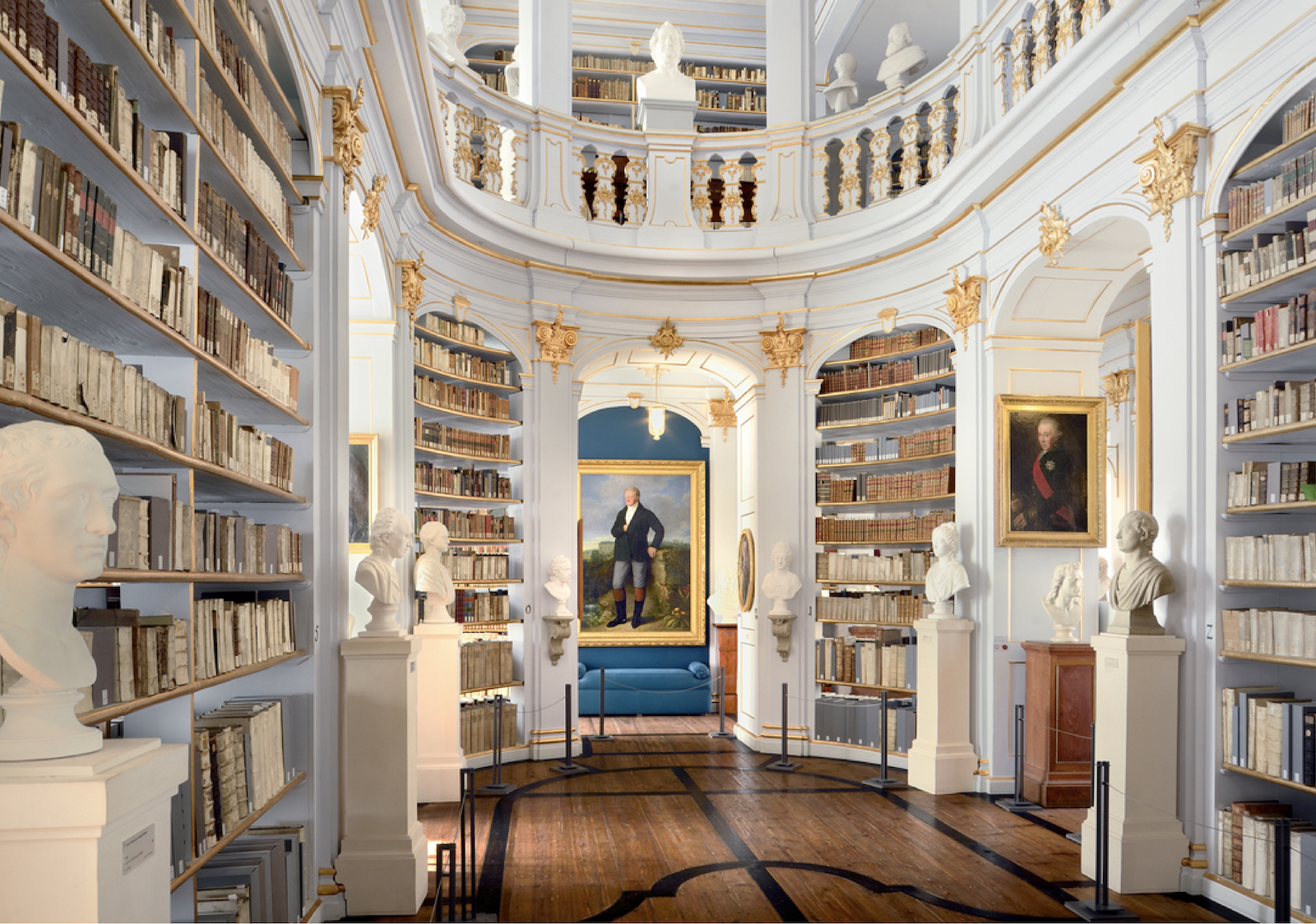
Rococo Hall in the Anna Amalia Library, UNESCO World Heritage Site. Photo © GNTB/Francesco Carovillano.
In the 18th century, Weimar flourished as a centre for the arts, thanks to Goethe’s good relations with an open-minded duke and his friendship with fellow literary giant Friedrich Schiller. However, Weimar was not just a muse for Goethe; it was also fertile ground for composers Franz Liszt and Johann Sebastian Bach, the latter a court organist who composed his Weimar cantatas starting in 1714. Weimar is connected to Luther’s Reformation and gave its name to the first modern German republic. Even Nietzsche spent his final years there.
Off the train from Berlin, I can see why my friends waxed so poetic. Weimar is a far cry from my adopted city and its polycentric, concrete sprawl. The square in front of me, August Baudert Platz, is encircled by buildings with mint-green and pastel-pink exteriors, and roofs of fire-engine red. Gold filigree adorns one façade, like spun sugar on an already elaborate cake.
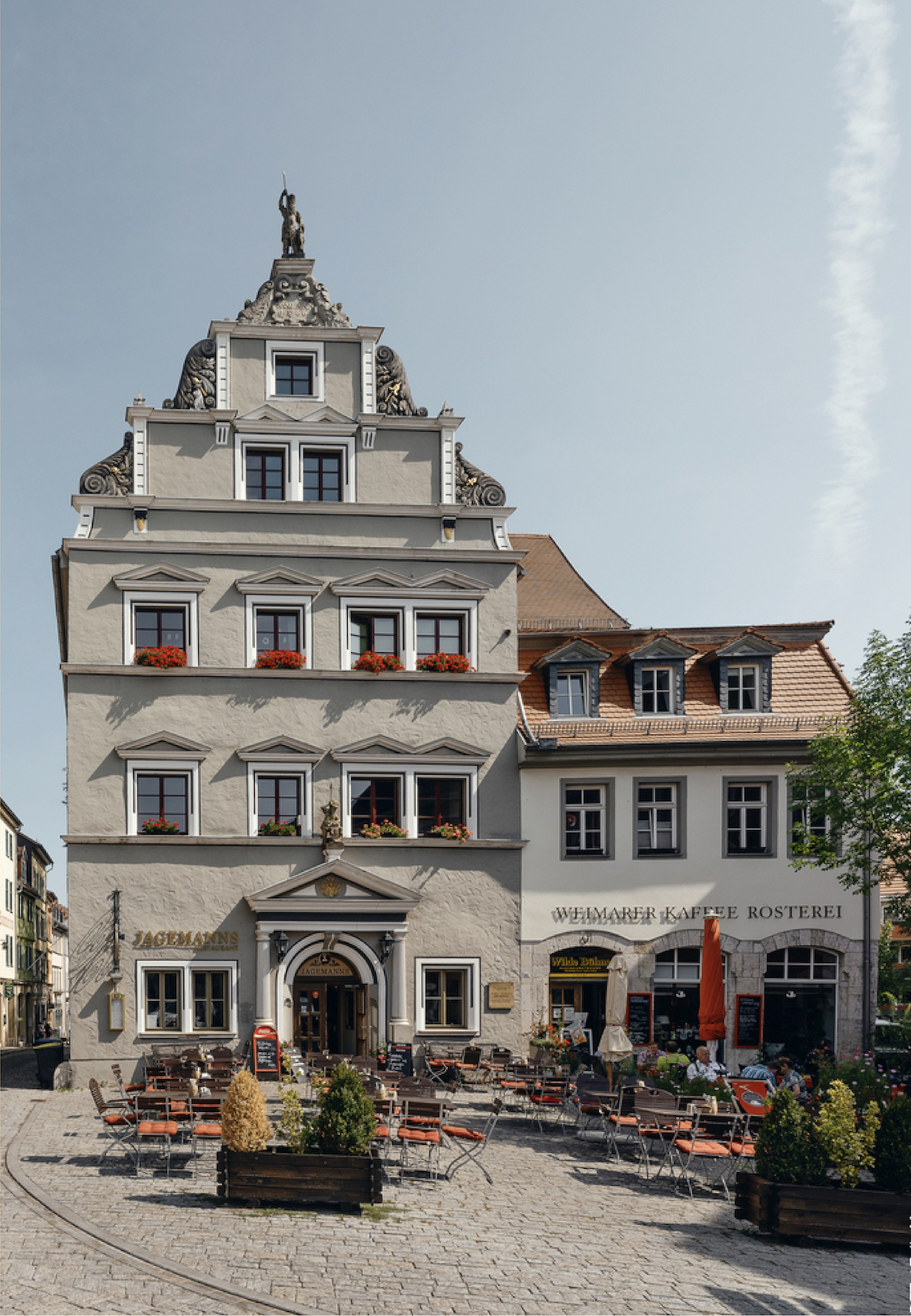
Photo by Felix Meyer.
But as we bounce over cobblestones on the bus into the city centre, I am confronted with something new, out of place. I peer out at large photographs nearly two metres wide. Is this part of an art installation, I wonder? The first poster I notice is plastered to a concrete wall. It’s a photo of an elderly woman sitting alone in her living room on a bright blue sofa. The corners of the print are already starting to peel. Another photo shows a huddle of artsy students playing chess in a communal space. It seems wherever I am, so are the pictures.
In the heart of the city, one photo gazes directly at Goethe’s baroque residence in Weimar’s main square. Indeed, Goethe and Schiller’s homes are both storied museums, filled with art and pianos and sculptures and sumptuous wallpapers. I have always been a voyeur, as if walking through the writing rooms of poets could divulge the secrets of their success, as if I could absorb some of their residual stardust. But what of these photographs?
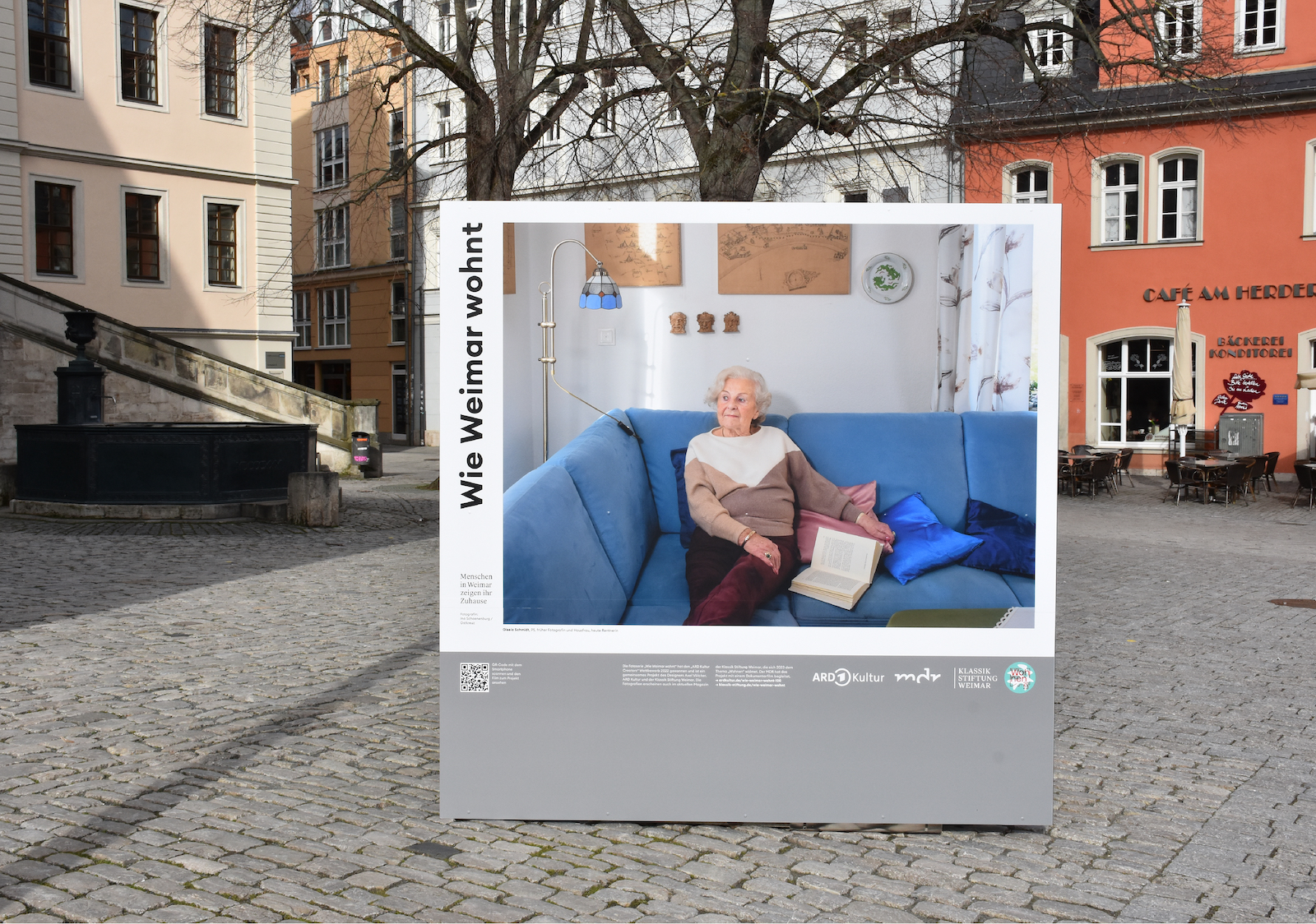
The public photo series Wie Weimar wohnt (How Weimar Lives) by Ina Schoenenburg celebrates the 100th anniversary of Bauhaus’s Haus am Horn. Photo by Lisa Bussler © KSW.
The answer can be found at Weimar’s Bauhaus Museum, a hulking grey structure built in 2019. I’m there to meet Sophia Schalt, the digital curator for the Klassik Stiftung Weimar, the cultural foundation that owns dozens of museums, palaces, and parks throughout the city. Weimar is also the birthplace of Bauhaus, the pioneering modernist school established by architect Walter Gropius in 1919. This year, the city is celebrating the 100th anniversary of the Haus am Horn, a prototype for German single-family homes that remains perched on the hill above the Park an der Ilm. The foundation’s theme this year is “living,” exploring the political and contentious aspects of how we coexist. It’s apt, as Europe struggles to emerge from its postpandemic energy crisis winter.
“It is kind of like living in a museum,” Schalt says of Weimar. “We were asking ourselves, ‘What can we actually do that has to do with us and the people living here?’” Alongside creating a new magazine, Klassisch Modern, the foundation enlisted the help of art director Axel Völcker, who came up with the straightforward idea of photographing Weimar’s residents in their homes. He commissioned the Berlin-based photographer Ina Schoenenburg, and the photo series Wie Weimar wohnt (How Weimar Lives) snowballed into a short documentary produced by ARD, Germany’s public broadcaster.
“It is such a cute little town. Very picturesque. We call it Disneyland, because everything is geared toward history, Goethe, and tourism.”
It’s part documentation and part art project, Schalt says. To begin, she went into supermarkets and out onto the street, asking Weimar residents if they’d like to participate. She wanted to shed light on the forgotten places in Weimar, the unadorned corners, from the homes of a pensioner to a single mother with seven children.

Photo by Lisa Bussler © KSW.
Völcker puts it bluntly in the documentary. “It is such a cute little town. Very picturesque. We call it Disneyland, because everything is geared toward history, Goethe, and tourism,” he says. “Goethe is everywhere,” he continues. “He is everywhere, and I am throwing him outside the room.”
Schoenenburg agrees. She is happy that the households, from different social backgrounds, have come together to form a snapshot of the city and its inhabitants. “For me,” she says, “this exhibition is a plea for a pluralistic society, a yes to diversity.” She mentions she especially likes a picture of a woman and her dog in a caravan, which is also her home. “The way this huge Great Dane piles up behind his mistress in the smallest space, with a melancholy look, moves me.”
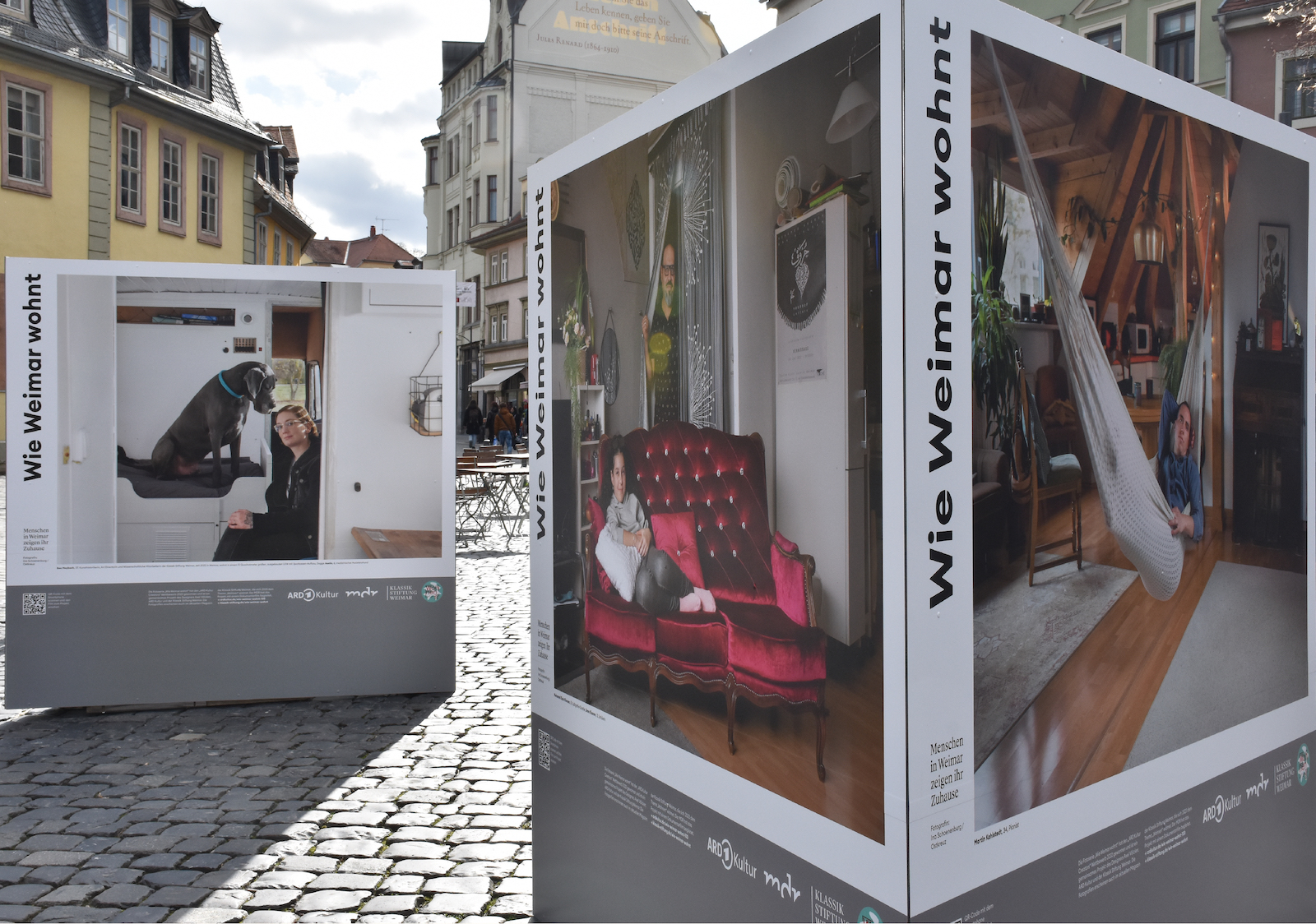
Photo by Lisa Bussler © KSW.
After my interview with Schalt at the Bauhaus Museum café, I say my thank yous and goodbyes and hustle along the Ilm river to the Haus am Horn, set in a romantic stretch of green. German writer Adolf Stahr wrote that “Weimar is actually a park in which a city lies.” Hurrying past Goethe’s garden cottage, I scramble up the side of an embankment to reach the Haus. On my way, I pass the villa where the artist Paul Klee lived when he taught at the Bauhaus. Out of breath, I finally enter the museum only to be told by the stern ticket officer that I’ve missed my time slot. She gives me five minutes.
Walter Gropius once asked, “How do we want to live?” and ushered in a movement that transformed the way we look at form and function. The Haus am Horn is a small white cube. Its many rooms feel empty, the hallways narrow. The model house was the only building constructed in Weimar by the Bauhaus, which relocated to Dessau in 1925 for political reasons. The house was an experiment, built for the 1923 Bauhaus Exhibition to demonstrate the school’s vision for contemporary living. Leaving the building, I take one last look back down at the park. The evening is beginning to lose its colour as I reflect on all the people who make up Weimar today. While they continue to honour the legacy of those who came before them, they wish to move forward, too.
Read more from our Summer 2023 issue.

